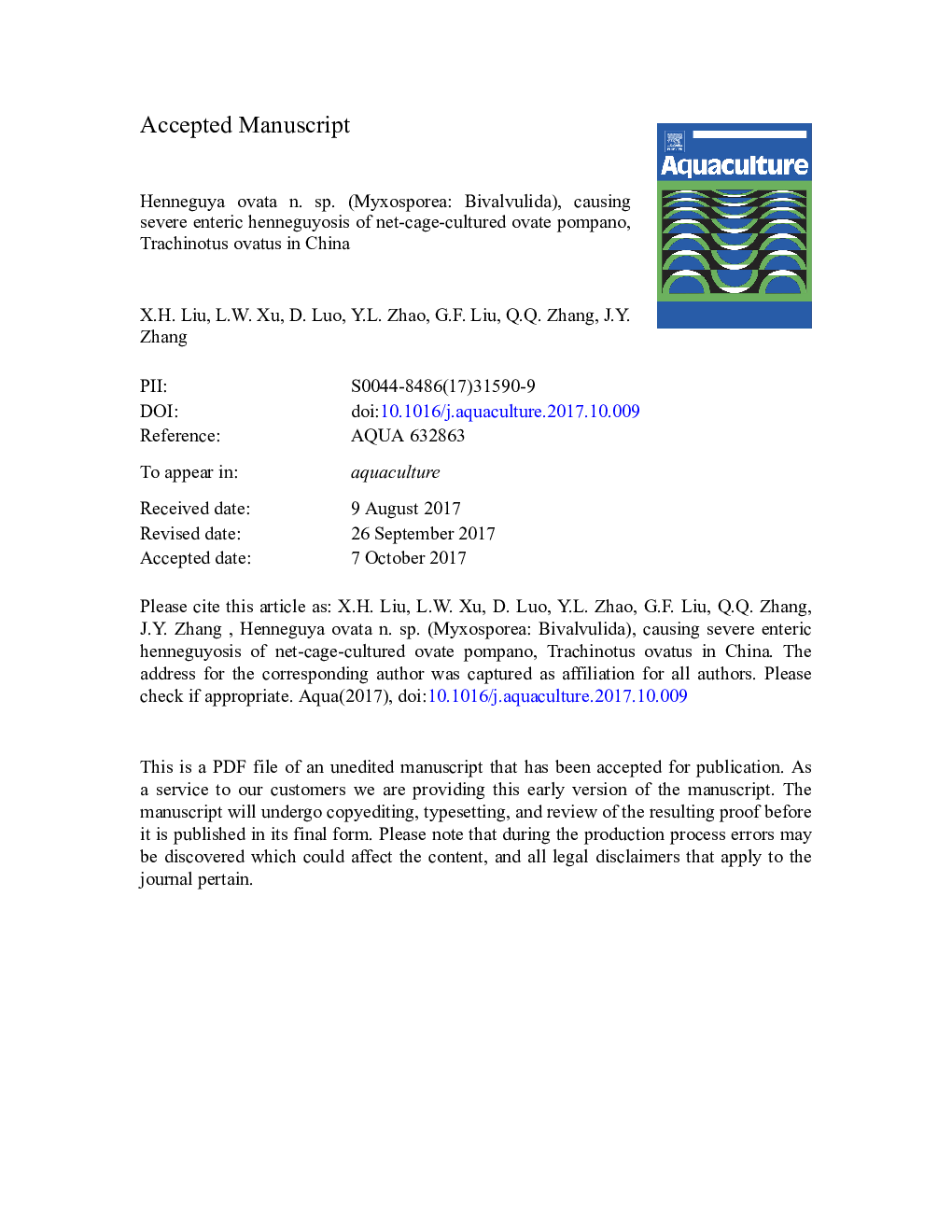| کد مقاله | کد نشریه | سال انتشار | مقاله انگلیسی | نسخه تمام متن |
|---|---|---|---|---|
| 5538980 | 1552805 | 2018 | 26 صفحه PDF | دانلود رایگان |
عنوان انگلیسی مقاله ISI
Henneguya ovata n. sp. (Myxosporea: Bivalvulida), causing severe enteric henneguyosis of net-cage-cultured ovate pompano, Trachinotus ovatus in China
دانلود مقاله + سفارش ترجمه
دانلود مقاله ISI انگلیسی
رایگان برای ایرانیان
کلمات کلیدی
موضوعات مرتبط
علوم زیستی و بیوفناوری
علوم کشاورزی و بیولوژیک
علوم آبزیان
پیش نمایش صفحه اول مقاله

چکیده انگلیسی
High diversity of fish myxosporeans was reported in China, but less concerns in species from marine environment, especially in South China Sea. Increasing myxosporidiosis of cultured marine fish expedite us to initiate a project of investigating the myxosporean diversity of marine fish in China. As a part of this project, a new myxosporean species, named as Henneguya ovata n. sp. was described here which intensively infected the internal wall of intestinal tract of net-cage-cultured ovate pompano, Trachinotus ovatus Linnaeus (1758) (Perciformes: Carangidae) off the coast of Huidong country, Guangdong Province, South China. The parasite generally produced white and usually round plasmodia, up to 3 mm in diameter. Mature spores with a bifurcated equal caudal appendage were elongated ellipsoidal in frontal view, with blunted round anterior end, measuring 15.8 ± 0.9 (14.7-17.1) μm in total spore length, 6.9 ± 0.3 (6.1-7.1) μm in spore body length, 3.3 ± 0.2 (2.9-4.1) μm in width, 2.9 ± 0.1 (2.8-3.3) μm in thickness. The caudal appendages were 8.9 ± 0.3 (8.1-9.6) μm in length. Two equal pyriform polar capsules situated in the plane of the suture line at the anterior end of spores, measuring 2.7 ± 0.1 (2.6-2.9) μm in length and 1.2 ± 0.1 (0.9-1.3) μm in width and occupied about half of the spore body length. Polar filaments wounded in 3 to 4 coils and situated perpendicularly of the longitudinal axis of the polar capsules. Morphological comparisons showed that the present species was smaller than most of reported Henneguya species. Under ultrastructural observations, numerous projections could be seen in the plasmodial wall toward host tissue. The obtained partial 18S rDNA gene sequences, 1675 bp in length, did not match any of myxosporeans available in the GenBank, but was most similar to two Trachinotus-infecting Henneguya species (about 91%). Phylogenetic analysis revealed that the parasite clustered within the marine Henneguya-Myxobolus clade infecting fish of the order Perciformes. Therefore, our results strengthened again the contention that the host affinity was the strongest among evolutionary signals to infer the phylogeny of myxosporeans of the family Myxobolidae. However, spore morphology and tissue tropism could represent well phylogenetic relationships among species of myxobolid group of within a short evolutionary history. Taking into account the high infection intensity and caused remarkable thin and transparent intestinal wall, the detrimental effects of infection of this myxosporean on cultured T. ovatus deserve more attentions in future.
ناشر
Database: Elsevier - ScienceDirect (ساینس دایرکت)
Journal: Aquaculture - Volume 483, 20 January 2018, Pages 8-15
Journal: Aquaculture - Volume 483, 20 January 2018, Pages 8-15
نویسندگان
X.H. Liu, L.W. Xu, D. Luo, Y.L. Zhao, G.F. Liu, Q.Q. Zhang, J.Y. Zhang,